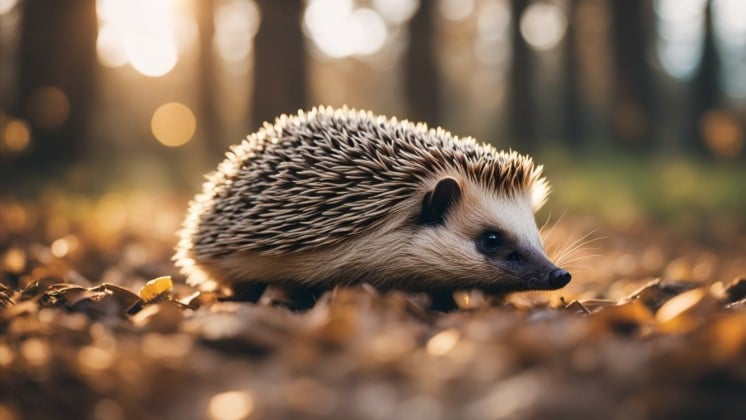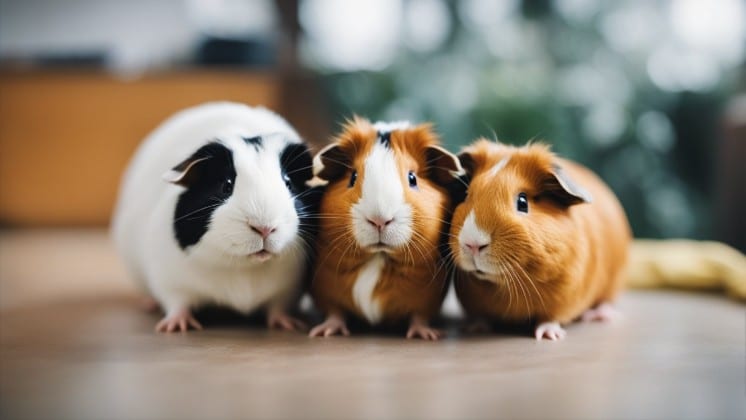Hedgehogs have been gaining popularity as pets in recent years due to their adorable appearance and unique personalities.
New pet hedgehog owners often don’t know how to handle these prickly balls, and there are some crucial things that every hedgehog owner should know.
Particularly a friend of mine has recently decided to purchase a pet hedgehog, and since she’s not a techy person, she asked me for some advice.
I decided it was time to research and learn everything to give her some tips on properly caring for her new pet.
So settle in, grab a cozy blanket, and get ready to learn about these spiky creatures cuddling behavior.
Let’s dive in!
Can you cuddle a pet hedgehog?
While not all hedgehogs enjoy being held or cuddled, many do if they have been socialized properly from a young age.
In the wild, hedgehogs are solitary animals that don’t naturally seek out human interaction. However, the domesticated pet hedgehog’ African pigmy hedgehog’ is known for their charm and bonding with humans.
In fact, these adorable mammals love to cuddle and bond with their owners if given the opportunity.
Here’s a video that shows just how cute and cuddly pet hedgehogs can be:
Let’s keep going.
Importance of the bonding process
Bonding with your pet hedgehog is crucial, especially if you want to regularly cuddle and interact with them. Hedgehogs are naturally defensive animals that curl into a tight ball when they feel threatened or scared.
It’s important to establish trust through bonding activities such as gentle handling, offering treats, and spending time with them in a quiet environment.
It’s important to note that not all hedgehogs will bond easily or quickly. Some may take weeks or even months to warm up to their owners, so patience is key.
How do you cuddle a pet hedgehog?
Before cuddling your hedgehog, it’s important to make sure they’re comfortable and relaxed. Otherwise, you risk getting poked by their spines.
Here are some tips on how to cuddle your pet hedgehog:
Offer a treat to establish trust
Start by offering your hedgehog a treat to establish trust. This will help them associate you with positive experiences and begin to feel more comfortable around you.
This is also known as positive reinforcement. A method that rewards good behavior by encouraging and reinforcing desirable behavior through offering treats or praise.
The purpose is to strengthen the likelihood that the desired behavior will be repeated in the future.
Of course, it doesn’t always work, but the more you do it, the more likely your hedgehog will associate you with positive experiences.
Hold gently
Use a soft, comfortable blanket or towel as a cuddle surface. Avoid picking up your hedgehog by its spines, as it can be uncomfortable. Instead, scoop them up with both hands and hold them close to your body in a gentle hug.
Position them on their back
Once your hedgehog is comfortable in your hands, you can position them on its back for a cuddle. This allows you to stroke their belly and chest, which many hedgehogs enjoy.
However, not all hedgehogs like being on their back, so paying attention to their body language and only doing what they’re comfortable with is important.
Gently massage their belly
Move onto massaging the areas without quills, such as their ears, face, belly, and paws. Softly rub each area while carefully avoiding touching their eyes and nose.
If you sense that your hedgehog has had enough of the massage or becomes agitated, stop immediately and put them back in their enclosure.
Pro tip: Keep messages short, from five to ten minutes tops, as they’re naturally active animals who prefer running to sitting still for long periods.
Creating a comfortable environment
Hedgehogs are sensitive animals that can get scared easily. Avoid sudden movements or loud noises when handling or cuddling your pet hedgehog, as it may startle them.
Creating a comfortable environment for your hedgehog is a must to ensure they feel safe and relaxed while cuddling.
Here are some tips on how to create a comfortable environment for your pet hedgehog:
- Choose a quiet space. Hedgehogs are sensitive to loud noises, so it’s important to choose a quiet room where they won’t be disturbed.
- Use soft blankets or towels as bedding. Hedgehogs have sensitive skin, so it’s important to use soft materials. Ensure you have plenty of extra blankets or towels on hand for snuggling.
- Keep the temperature warm. Hedgehogs prefer a warm environment, so ensure your room is kept at a comfortable temperature. You can also provide a heat lamp or heating pad under their blanket.
- Be gentle when handling. Be gentle when picking up and holding your hedgehog, and avoid squeezing too tightly. Remember that they are small creatures with delicate bones.
How do you know if hedgehogs like to be cuddled?
Hedgehogs are adorable, and some owners may want to cuddle with them, but it’s important to remember that not all hedgehogs like being handled or cuddled. In fact, many of them find it very stressful and uncomfortable.
So how do you know if your hedgehog likes to be cuddled?
One indication is their body language. If your hedgehog enjoys being around you, it will generally be more relaxed when you approach them. They might even come running up to you or climb onto your lap.
However, if your hedgehog is uninterested in being held, it may curl up into a tight ball or try to run away when approached. These are signs that they feel stressed or threatened and should not be handled immediately.
It’s important to understand that even if your hedgehog enjoys being held or cuddled sometimes, it still needs plenty of time on its own.
Hedgehogs are mostly nocturnal animals that prefer to sleep during the day, so it’s best not to disturb them too much during those hours.
If you want to interact with your hedgehog in a way they will enjoy, try providing them with toys and treats instead of always picking them up. You can also spend time near their enclosure, whispering or offering gentle pets while they explore on their own terms.
Remember, each hedgehog has its own personality and preferences. Always pay attention to your pet’s behavior and body language to better understand what they enjoy and what makes them uncomfortable.
Do hedgehogs show affection?
Hedgehogs are generally solitary animals and do not show affection in the traditional sense, meaning they don’t display affection like dogs or cats. However, hedgehogs can bond with their owners and show signs of trust and comfort around them.
In fact, there are some signs of bonding that hedgehogs may display toward their owners, such as:
- Relaxed posture. A hedgehog that enjoys being cuddled will often have a relaxed body posture, with its quills lying flat and its limbs limp.
- Spending time near their owner. They may approach their owner when they enter the room or climb onto their lap for snuggles. This is a sign that your hedgehog trusts you and enjoys being in your company.
- Snuggling. This kind of behavior in hedgehogs is often associated with feeling safe and comfortable, and it’s a good indication that they trust you.
Can hedgehogs cuddle with each other?
Hedgehogs are generally solitary animals and don’t enjoy the company of other hedgehogs. They prefer to live alone and can become aggressive towards other hedgehogs if forced to share their space.
However, in rare cases where two hedgehogs have grown up together from a young age or have been carefully introduced, they may tolerate each other’s company and even cuddle or snuggle together.
That said, this is not typical behavior for hedgehogs, and it’s important to monitor their interactions closely if you choose to house multiple hedgehogs together.
If you have a pet hedgehog and want to introduce another one into their home, it’s best to do so gradually and under supervision. Start by allowing them to sniff each other through a barrier like a cage or a playpen before allowing direct interaction.
It’s also important to provide ample space, food, and hiding spots for each hedgehog in case they need time apart.
Summary
Before we move on to the conclusion, we’ve summarized this article into a short list of key points for you to remember:
- Remember to watch for body language and signs of stress in your pet hedgehog to determine if they enjoy being held or cuddled.
- Hedgehogs are generally solitary animals and do not show affection traditionally, but they can bond with their owners and show signs of trust and comfort around them.
- If you have two hedgehogs, monitoring their interactions is vital if you choose to house them together.
Final thoughts
There you have it! This guide has given you a better understanding of hedgehogs and their cuddly nature. While they may not show affection like traditional pets, hedgehogs can bond with their owners and enjoy spending time with them.
Want to learn more about hedgehogs?
Ready to boost your knowledge to the next level? If so, check out the articles below:
- Do Hedgehogs Eat Mice? (Explained)
- Cost to Own a Hedgehog: Everything You Need to Know!
- How Long Can a Hedgehog Be Left Alone? (Read This First!)






